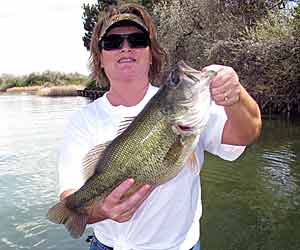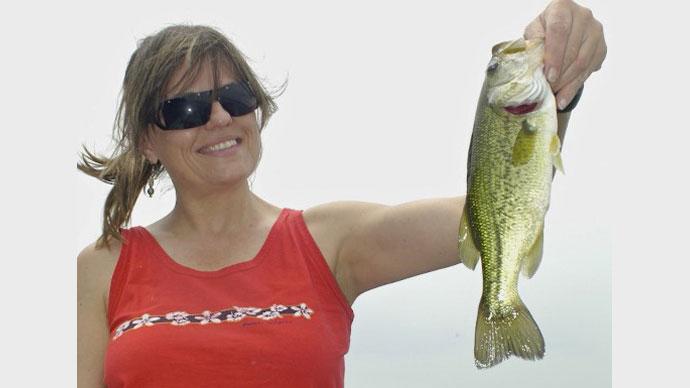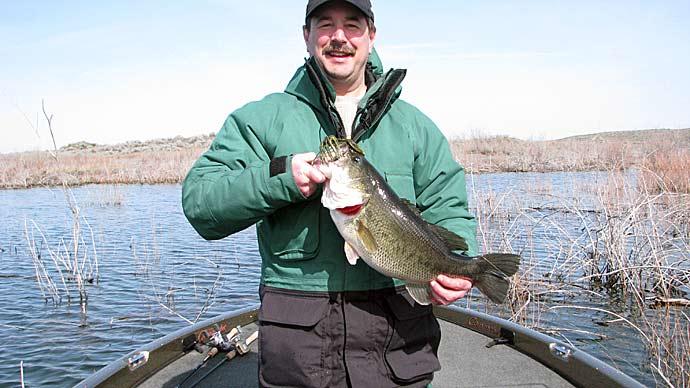
Bass are not only a fisherman's favorite, but they are also a key component to a healthy pond. A proper number of bass of varying size and age will keep other fish populations in check, which keeps a balanced food chain.
If you choose to stock your pond with adult bass, do so carefully, in small amounts. Five bass per acre will make a significant impact on the fishery. Never stock more than 12 fish per acre into a pond with no bass.
If the pond already has a few bass, I don't recommend stocking more than six fish per acre. Stocking more bass than that will lead to extremely bass heavy populations (i.e. too may bass in the pond).
When this occurs, the bass will eat up all the small baitfish in the pond. Once forage have been depleted, the bass will stop growing. Fish need food to grow. They are not like us. They can grow their entire life, if sufficient food is available. When stocking adult bass, it is critical to make sure the food chain is established. By 'established,' that usually means the pond has small bluegill (1-2 inches long), intermediate bluegill (3-6 inches) and large bluegill (that are greater than 6 inches).
If bluegill are all one size, the pond owner should consider stocking larger bluegill and start stocking bass very slowly (1-2 fish per acre).
Bass are predators. As such, they eat other fish and do it well. They have an attitude similar to lions. Imagine putting lions in the woods to control a deer population. It would not take very many big cats to change the deer numbers; it does not take many bass to control other fish populations.
A perfect example of how bass can control a pond's population can be found at 35-acre Bailey Lake in northern Georgia. A community association owns this lake along with two others. I was first called out to Bailey Lake in 1997 for an aquatic weed control problem.
I found a lake that was filled with extremely dense watershield, making fishing from the bank difficult. Using an electric trolling motor was impossible.
This watershield problem, along with some pondweed, put bass at a disadvantage. Bass simply could not catch the baitfish hiding in the dense weed growth. After some serious aquatic herbicide application, the watershield was eradicated from the pond. Along the way, these treatments also eradicated the fund the community association had set up for managing the lakes.
The following year the community decided that managing the lakes would be more cost-effective than managing the damage control, so they signed me on. The first shocking survey revealed some interesting critters.
Turns out, Bailey Lake has a diverse fish population, with bass, bluegill, warmouth, green sunfish, shellcracker, crappie, brown bullhead catfish and gizzard shad. Of all the fish we sampled, the gizzard shad made us take notice. The large filter-feeders dominated the lake; you could see them cutting around the surface of the pond 100 yards ahead and behind the shocking boat. There were ten large shad for every bass, and the shad were as large as the bass.
I formulated a plan to harvest the giant shad. The plan involved three shocking boats, several hundred yards of gill nets, and a large hole above the shoreline to 'store' the surplus shad. Eager to get to work, I presented my plan to the community.
The community board was not ready to fund the challenge, and they were not happy with the idea that I was going to be putting large numbers of their fish in a hole to die. My plan was shot down faster than an Iraqi fighter pilot.
That sent me back to Square One. I now must figure a way to rid the lake of large shad while using no nets, no poison and no extra shocking boats. I had to fix this all by myself, with a modest budget.
I began my due diligence by reading up on gizzard shad, and found several interesting clues to the mystery of how to fix Lake Bailey. Gizzard shad only spawn once per year, and they only live for about five years. I also discovered that if shad are crowded, they release a chemical into the water that discourages them from spawning. Mother Nature's own birth control.
Armed with my new knowledge, I started checking the other lakes on the property and was surprised to learn the other two lakes had no shad. Bailey Lake drained directly into the lakes, and with large rainstorms, it would be easy for shad to move down the spillway and into the other lakes. I concluded that the gizzard shad were a recent introduction, probably from a fisherman. Gizzard shad are a favorite live bait at Lake Lanier, a local reservoir known for its high-quality striper fishing.
The gizzard shad were introduced into a lake that had a weed problem. The fish became crowded because the weeds were so dense, the bass could not eat the young shad. As a result, the unchecked shad grew rapidly and moved out into open water where the bass have little predatory advantage. The shad were so successful they had become crowded, and stopped reproducing all together.
So, instead of harvesting tons of shad from the pond, I decided to let nature take its course. Since shad only live for five years, I decided to let them die out naturally. Once shad numbers dropped, I assumed they would begin spawning again. With the weed problem under control, it would be easy for bass to eat baby shad. I began stocking adult bass into Bailey Lake.
Adult bass are sometimes available through hatcheries but always expensive. I've heard of hatcheries selling them for as much as $10-$12 a pound for a 5-pounder. Instead, I got the bass from shocking surveys that I conducted in the area.
Most of the lakes in Georgia are bass-heavy, so finding a few extra bass was easy. I stocked four bass per acre, 140 bass total over a two-year period in groups of 10-30 fish. The stocking was completely random over those two years.
Today, the lake is no longer dominated with large shad. The average size shad is seven inches and the bass population looks great. Fishing is excellent and the lake association is happy.
Over the past several years, I have been in similar situations with different competing fish species, like crappie and green sunfish. I have found that adding additional adult bass is excellent for controlling overcrowded crappie populations. I have controlled competing species by stocking adult bass at a rate of 5-10 bass per acre.
I have also stocked several ponds that do not contain any bass. I stock adult fish at a rate of 12 fish per acre. Since the stocking rate is so low, I make sure the bass have different genetic backgrounds to ensure diversity. I like to stock a few pure Florida-strain bass along with some Fl bass and some pure northern strain.
I use the gizzard shad example because they are very difficult to control. If you can control gizzard shad with light stockings of adult bass, you can control any unwanted/out of control fish. The reason gizzard shad are hard to control is they filter the water of plankton for food. All they eat is plankton, and since they are plankton eaters, they can swim anywhere in the pond to eat, so they prefer large open water areas where they can see the other fish around them. In contrast, look at the biology of the bass. It is an ambush predator. It likes to hide behind things and wait for an unlucky fish to venture too close, then WHAM. It attacks and swallows its meal whole. This physiology makes eating gizzard shad difficult because it's difficult to get out in the middle of the lake and find something to hide behind. Advantage: Shad.
The only time bass are at an advantage is the spring when shad are spawning. Shad move into shallow water areas to have their young. The trick is to have enough bass around to eat the baby shad before they have an opportunity to move back to the open water. However, you can't have too many bass, or the bass will not grow properly.
There are many other species of fish that can cause problems with the balance of the fish population. But these fish feed in similar areas and live in similar habitat as bass. Therefore, it is easier to control these fish by stocking additional bass because they inhabit the same areas of the pond. The stocking rates I suggest will work no matter what type of fish is causing problems. Five bass per acre will change the dynamics of a pond no matter what other fish is causing problems.
However, I had to solve the opposite problem of an overcrowded bass population. I have been working a pond for about four years. It was stocked with adult bass six years ago at a rate of 20 bass per acre.
Currently, I 'am still removing small bass because the population got so crowded in two years. Twenty bass per acre will reproduce and overcrowd in 1-2 years.
Therefore, bass can be used as a natural control to fish populations, as long as the food chain is kept in check. Too few bass will not be able to control other fish populations; too many bass will deplete the pond of its resources.
If adult bass are needed, stocking them at a rate of 5-10 bass per acre will help maintain a pond's food chain and result in a healthy, thriving pond.
Reprinted with permission from Pond Boss Magazine



